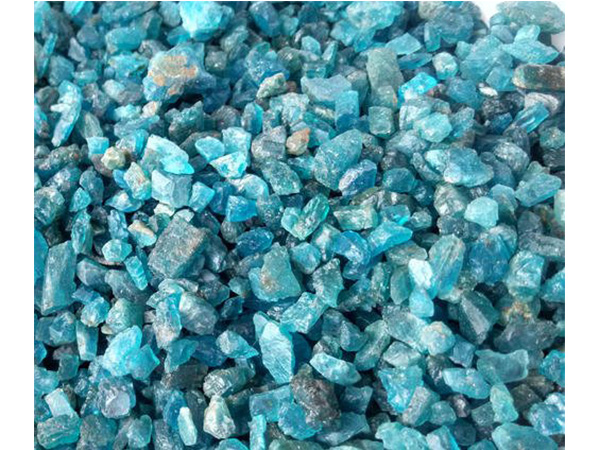APATITE

Apatite is the most important mineral raw material for the manufacture of phosphate fertilizer and phosphorus and its compounds. The most common apatite is fluoroapatite. In addition to the fluoride anion, there are chloroapatite, hydroxyapatite and the like according to the addition anion. The shape of the apatite is glassy crystal, block or tuberculosis, and the color is various, and it is mostly a hexagonal column with a tapered surface. Apatite is found in various igneous rocks as secondary minerals.
It can form industrially valuable deposits in alkaline igneous rocks, such as the Xibinai apatite-nepheme mine in the Kola Peninsula, Russia. The large-scale apatite deposits are mainly shallow-sea sedimentary rocks, mainly composed of collo-phosphorus ore. Such as China's Hubei Fuyang, Yunnan Kunyang and Guizhou Kaiyang Phosphate Mine. It is also possible for them to form sedimentary metamorphic deposits. The guano manganese phosphate ore formed by biochemical action is mainly composed of hydroxyapatite.
Introduction
Apatite is a general name for a class of calcium-containing phosphate minerals. Its chemical composition is Ca5(PO4)3(F, Cl, OH), which contains 55.38% of CaO, 42.06% of P2O3, and 1.25% of F. The Cl content was 2.33% and the H2O content was 0.56%. The crystal belongs to the hexagonal system. The most common mineral species is fluoroapatite Ca5(PO4)3F, followed by chloroapatite Ca5(PO4)3Cl, hydroxyapatite Ca5(PO4)3(OH), oxysilicon apatite Ca5[(Si , P, S) O4] 3 (O, OH, F), strontium apatite Sr5 (PO4) 3F, and the like. Apatite crystals are common, generally hexagonal columns with cones; aggregates are granular, dense blocks, tuberculosis; variants in colloidal form are called apatite, and their ore is called colloidal phosphate.
Mineralogy
The apatite is light green, yellowish green, brownish red, etc., and the glass is lustrous. With incomplete cleavage, the fracture is not flat. The fracture has a shell shape, a grease luster, and many kinds of apatite have fluorescence. Usually a variety of apatite contains impurities such as fluorine, carbon, chlorine, uranium, manganese and other rare elements. Moss hardness 5, specific gravity 3.18 ~ 3.21. Phosphorescence often occurs after heating.
The ammonium molybdate powder is placed on the apatite, and nitric acid is added to form yellow ammonium phosphomolybdate for rapid phosphorus determination. As a secondary mineral, apatite is found in various igneous rocks. It can form industrially valuable deposits in alkaline rock, such as the Xibine apatite-nepheme mine in the Kola Peninsula, Russia. The large-scale apatite deposits are mainly sedimentary genesis of shallow seas, mainly composed of collo-phosphorus ore, such as China's Fuyang, Hubei, Kunyang, Yunnan, Kaiyang, Guizhou, or sedimentary metamorphic deposits formed by metamorphism.

Generation method
There are three ways to form apatite, which are formed in igneous rocks, sedimentary rocks and metamorphic rocks, and endogenous apatites formed in igneous rocks are generally enriched as basic by-products in basic or alkaline rocks; Exogenous apatite, formed by biodeposition or biochemical deposition, is generally tuberculous; it is formed in metamorphic rocks by regional metamorphism.
When the crystal is large, crystal form, color, gloss, and hardness can be used as identification features. If it is in a finely dispersed state, it needs to be identified by chemical analysis.
application
Apatite is an important raw material for extracting phosphorus and manufacturing agricultural phosphate fertilizer. The apatite with good color and crystal can be used as a gemstone or decorative material. Apatite with many associated elements can be comprehensively utilized. Apatite is the main inorganic substance in the human and animal hardware (tooth, bone, stone) and an important biological material.
Phosphates include normal phosphate salts and acid salts. Apatite is an important mineral for the extraction of phosphorus, of which fluoroapatite is the most important mineral in the trade. The shape of apatite is glassy crystals, blocks or tuberculosis. They are various in color and are generally hexagonal columns with a tapered tip. Most apatites are pure, and if they are harder, they can be used as gems. Phosphorescence is often emitted after the apatite is heated. The shadow of apatite can be seen in various igneous rocks.

Hexagonal system, a0=0.943~0.938nm, c0=0.688~0.686nm.Z = 2.The basic features of the crystal structure are as follows: the ca-o polyhedron is in the shape of a triangular column, connected by edges and corner tips, and an irregular chain extends along the c-axis. The chains are connected by [PO4], forming a channel parallel to the c-axis. Additional anions Cl-, F- and OH- are also arranged in the channel as chains.F-ca coordinating octahedral angular apex Ca is also connected to O2- at the top of 6 of the adjacent 4 [PO4] angles.
Birth and combination
Apatite is found in various igneous rocks as secondary minerals. It can form deposits with great industrial value in sedimentary rocks, sedimentary metamorphic rocks and alkaline rocks. It is a secondary mineral in various magmatic rocks and granitic pegmatites.
The large-scale apatite deposits are mainly shallow sea genesis, or sedimentary metamorphic deposits formed by their metamorphism, mainly composed of phosphate rock. Such as China's Hubei Fuyang, Yunnan Kunyang, Guizhou Kaiyang Phosphate Mine.
Oreological significance
Brief history of mining
The first phosphate rock discovered and first exploited in China is the Haizhou Phosphate Mine in Jiangsu Province. The Haizhou Phosphate Mine (now known as Jinping Phosphate Mine) was discovered during the Tongzhi Period of the Qing Dynasty and was officially mined in 1914. In the 1920s and 1930s, geologists conducted a geological survey of the Jinping Phosphate Mine. In 1947, the phosphate rock was identified as a sedimentary metamorphic phosphate deposit. After the founding of New China, the country first explored and developed the Jinping Phosphate Mine.

Since the advent of the Kunyang phosphate mine in Yunnan, large phosphate mines such as Haikou, Jinning, Anning and Jiangchuan have been discovered around Yunnan Dianchi. Shortly after the discovery of the Kaiyang Phosphate Mine in Guizhou, the Lu'an Phosphate Mine was discovered. Inspired by the prospecting results of the Yichang and Jingjing phosphate mines in Hubei, the Baokang Shennongjia and Xingshan phosphate mines were discovered.
After the founding of the People's Republic of China, Chinese geologists conducted extensive geological surveys and explorations on the former Sinian metamorphic phosphate rock, the Sinian Doushantuo Formation and the Dengying Formation phosphate mine, the Lower Cambrian Meishu Village Formation and the Xinji Formation phosphate rock.
Evaluation work. In addition, geological research work has been carried out on the magmatic rock-type apatite deposits in North China, the guano deposits in the Xisha Islands, and the secondary phosphate deposits in Hunan and Guangxi. After the geological survey, the pre-Sinian sedimentary metamorphic phosphate rock deposits such as Jinping, Feidong and Susong; the Sinian Doushantuo group of Kaiyang, Chun'an, Yichang, Jingjing and Chaoyang;
Phosphorite deposits of the Lower Cambrian Meishucun Formation in Yang, Haikou, Leibo, Mabian and Ningqiang; the Middle Cambrian Da Maoqun Phosphorite deposit, and the Hebei Elk magmatic rock type apatite deposit, etc. A detailed geological exploration work has yielded a large amount of industrial reserves.
The countries producing gem-quality apatite in the world include Myanmar, Sri Lanka, India, the United States, Mexico, Brazil, Canada, Norway, Spain, Portugal, Italy, Germany, Madagascar, Tanzania, and China.
processing methods
There are three processing methods for apatite, namely mechanical, acid and thermal processing. Both domestic and foreign are based on acid processing.
(1) Acid processing
Phosphate rock powder is decomposed with various inorganic acids, and the obtained products are mainly various water-soluble phosphate fertilizers and phosphates. The main products are: superphosphate, extracted phosphoric acid, heavy superphosphate, ammonium phosphate, nitrophosphate and so on. In addition to superphosphate, it is a high concentration of phosphate fertilizer or compound fertilizer. The manufacture of these phosphate fertilizers requires apatite P2O5 ≥ 28%, and the impurity content and particle size should meet the requirements.
(2) Thermal processing
Use apatite and silica, magnesium-containing rock to form an appropriate ratio, melt in high temperature in a blast furnace or electric furnace, and then water-quench to prepare calcium, magnesium and phosphate fertilizers, etc.
Classification distribution
Hydroxyapatite
English name: Hydroxyapatite
Molecular formula: Ca10(PO4)6(OH)2
Molecular weight: 1004
Physical and chemical properties: Melting point: 1650 ° C, specific gravity: 3.16 g / cm, solubility: 0.4 ppm, Ca / P: 1.67
Crystal structure: hexagonal crystal system
Product specifications: powder, porous particles, block (non-calibrated) products
Application areas: bone substitute materials, plastic surgery and cosmetic surgery, dental, chromatographic purification, calcium supplements
Method: Ca(PO4)2 and CaCO3 can be reacted at a high temperature and simultaneously injected with high-pressure steam. The powder is dried by washing with NH4Cl aqueous solution and dried. It is divided into porous type and compact type. The former is powdered after foaming. It is prepared by sintering at 1250 ° C, and the latter is formed by sintering at 1250 ° C.
Distribution: It is widely distributed in human body and milk. The human body is mainly distributed in bones and teeth. The milk is mainly distributed in casein micelles and whey.

Fluorite is a common calcium fluorophosphate mineral. It exists in almost all igneous rocks and in magnesium mines. Fluorite apatite has a glassy luster and is available in a variety of colors, but in green. Generally, it is columnar or thick plate crystal, coarse grain to dense block or tumor.
The apatite is ground into phosphate rock powder and used directly as an acidic soil fertilizer. The grinding degree of the ore powder generally requires more than 90% of 100 mesh, and the ore is required to contain P2O510% to 20%, and there are no special requirements for other impurities.
